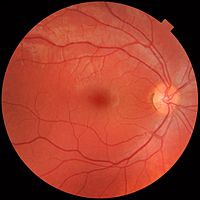
Photo from wikipedia
Multispectral imaging (MSI) of the retina and choroid has increasing interest for better diagnosis and treatment evaluation of eye diseases. However, currently available MSI systems have a limited field of… Click to show full abstract
Multispectral imaging (MSI) of the retina and choroid has increasing interest for better diagnosis and treatment evaluation of eye diseases. However, currently available MSI systems have a limited field of view (FOV) to evaluate the peripheral retina. This study is to validate trans-pars-planar illumination for a contact-mode ultra-widefield MSI system. By freeing the available pupil for collecting imaging light only, the trans-pars-planar illumination enables a portable, non-mydriatic fundus camera, with 200° FOV in a single fundus image. The trans-pars-planar illumination, delivering illumination light from one side of the eye, naturally enables oblique illumination ophthalmoscopy to enhance the contrast of fundus imaging. A broadband (104 nm) 565 nm light-emitting diode (LED) is used for validating color fundus imaging first. Four narrowband (17-60 nm) 530 nm, 625 nm, 780 nm, and 970 nm LEDs are tested for MSI. With 530 nm illumination, the fundus image reveals retinal vasculature predominantly. 625 nm and 780 nm illuminations enhance the visibility of choroidal vasculature. With further increased wavelength of 970 nm, the fundus image is predominated by large veins in the choroid, with multiple vortex ampullas observed simultaneously in a single fundus image.
Journal Title: Biomedical optics express
Year Published: 2020
Link to full text (if available)
Share on Social Media: Sign Up to like & get
recommendations!